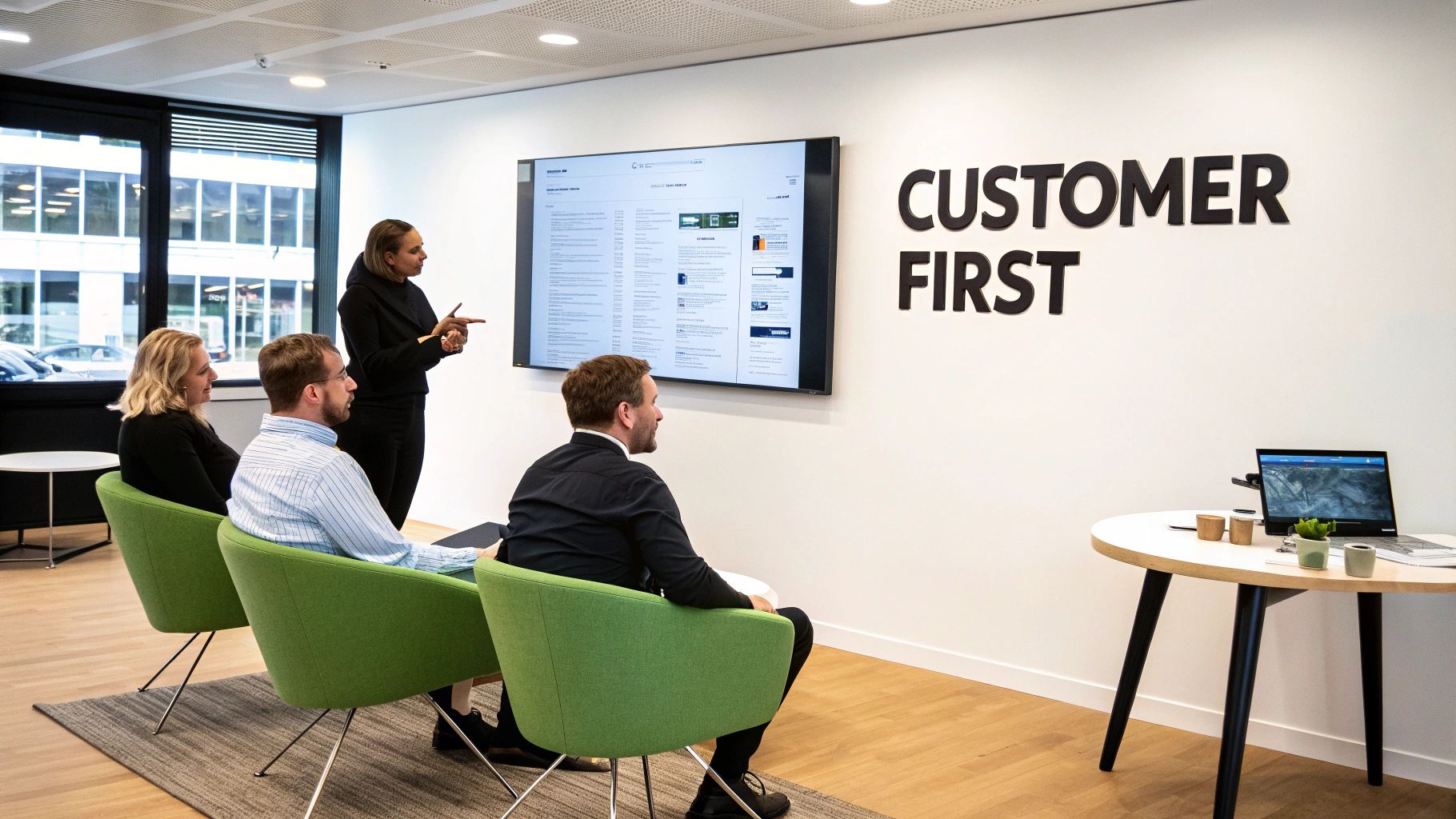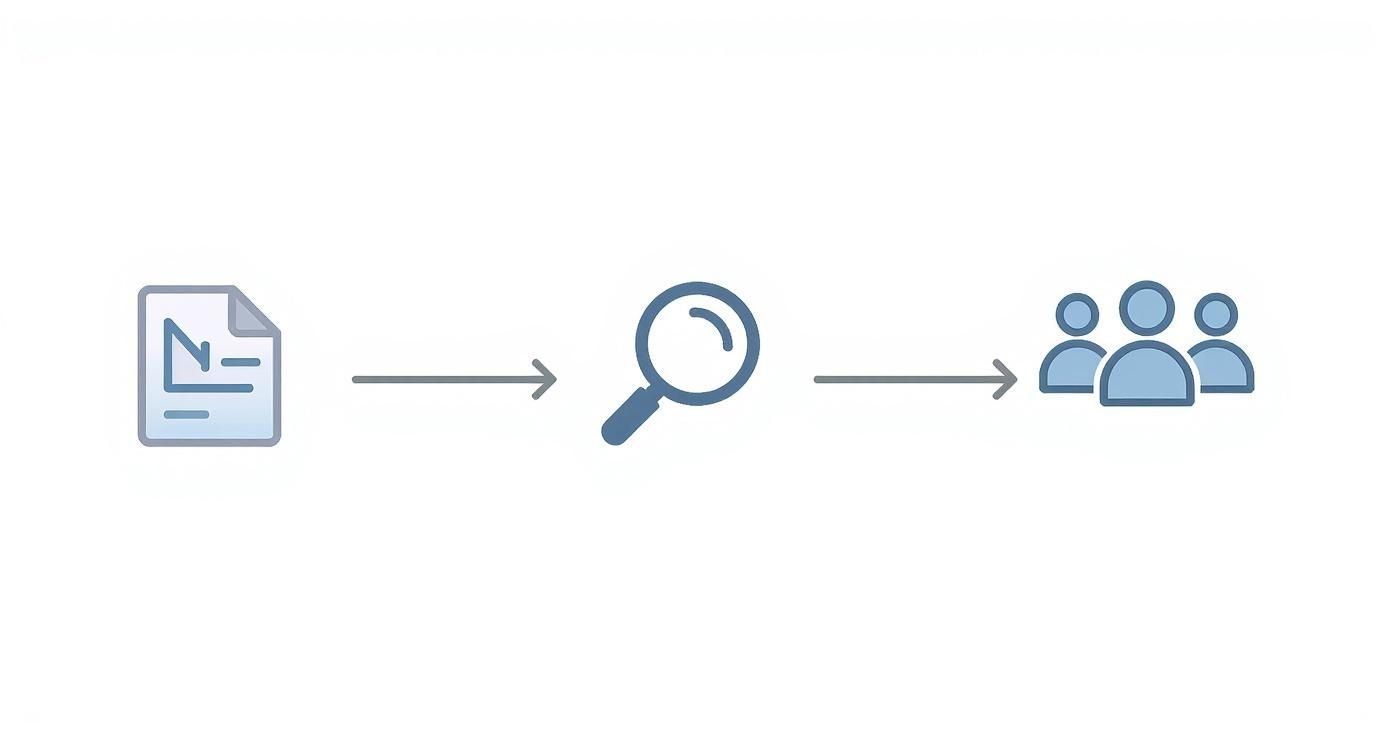
How to Create User Personas That Drive Results
0
6
0
So, what are user personas? In a nutshell, they’re about getting to know your audience’s habits and what makes them tick, then creating semi-fictional characters to stand in for your key customer types. This whole process turns a pile of abstract data into relatable people, guiding every business decision you make. It ensures that the products you build and the marketing messages you create actually land with the people you’re trying to reach.
Why User Personas Are a Strategic Business Tool

It’s tempting to see user personas as a bit of creative fluff—a box-ticking exercise for the design team before the real work starts. But that completely misses the point. Properly researched personas are so much more than character sketches; they are the strategic foundation that gets your entire business focused on the one thing that truly matters: your customer.
They become a shared reference point, putting a stop to costly mistakes and ending those endless internal debates about what customers really want. Instead of winging it based on guesswork, your team can ask, "What would 'Marketing Manager Maria' think of this feature?" That one simple question can save you an incredible amount of time and money.
Aligning Teams and Driving Decisions
Picture this: your marketing team is running a campaign targeting a young, budget-conscious audience, while your product team is busy developing premium, high-cost features. It’s a classic disconnect, and it happens all the time. This is a fast track to wasted effort and a confused brand message. Personas are the glue that holds your entire strategy together, making sure every department is singing from the same hymn sheet and talking to the same person.
By embedding a customer-first mindset into your company’s DNA, personas influence pretty much everything. They help you:
Refine Marketing Messages: You can craft copy, content, and campaigns that speak directly to your audience's specific goals and pain points.
Guide Product Development: It becomes easier to prioritise features that solve real problems, rather than adding shiny new functions that nobody actually asked for.
Improve User Experience: You can design websites and services that feel intuitive and genuinely helpful because you understand the people navigating them.
By turning abstract data into relatable human stories, personas make it possible for everyone—from developers to the sales team—to build with empathy. They become the North Star for every decision, ensuring the customer's voice is always present in the room.
From Good Idea to Essential Tool
Ultimately, creating user personas isn’t just about "understanding your audience"—it's about building a smarter, more focused business. They're a core piece of a strong business identity, just as vital as your logo or mission statement.
In fact, if you look at many incredible brand strategy examples, you'll find that a deep knowledge of the customer—often captured in personas—is the secret sauce behind their success. When you know exactly who you're serving, every choice becomes clearer and far more impactful.
Ready to stop guessing and start building a strategy based on deep customer insight? Let's dive into the practical steps of gathering the data that will bring your personas to life.
Gathering Your Raw Customer Data

Here’s the thing about personas: if you’re just making stuff up based on assumptions, you’re not creating a strategic tool. You’re just writing fiction.
Authentic, hard-working personas are built from one thing and one thing only: real data. The good news? You don’t need a massive budget to dig up the rich insights you need to truly get your audience.
The goal is to gather a mix of quantitative data (the ‘what’) and qualitative data (the ‘why’). Quantitative gives you the hard numbers—what people are doing. Qualitative gives you the context—why on earth they’re doing it. Learning how to conduct user research is your foundational first step.
Uncovering The Why With Customer Conversations
Honestly, your most powerful insights will come straight from the source. Having a real conversation with a customer, even just a handful, will uncover motivations and frustrations that Google Analytics will never show you.
Don’t think of these as formal, stuffy interviews. Frame them as simple, friendly chats. Reach out to a few recent customers and ask if they'd spare 15 minutes to share their experience.
Here are a few open-ended questions to get the ball rolling:
"Can you walk me through what you were trying to solve when you first found us?" This gets them talking about their initial problem in their own words.
"What was the biggest challenge you faced before using our service?" This cuts straight to their core pain points.
"Was there anything that nearly stopped you from choosing us?" This question is gold for uncovering hesitations and friction points in your process.
The key is to just listen. Seriously. Let the customer guide the conversation, and you'll be amazed at what you learn.
Designing Surveys That Deliver Patterns
While chats give you depth, surveys give you scale. They’re perfect for spotting broad patterns and backing up the qualitative gems you’ve already collected. Tools like Google Forms or Typeform make this ridiculously easy and affordable.
Keep your surveys short and sweet—aim for something that takes no more than 5 minutes to complete. A mix of multiple-choice questions with a couple of open-ended ones usually works best. For example, ask about their job role (multiple choice), then follow up with an open-ended question like, "What's the most time-consuming part of your workday?". This combo gives you clean data and rich, personal context.
A classic mistake is asking leading questions. Don't ask, "Was our checkout process easy?"—it practically begs for a 'yes'. Instead, try "How would you describe your experience with our checkout process?". That tiny shift invites a much more honest and detailed response.
Tapping Into Your Existing Data Goldmine
You’re probably already sitting on a treasure trove of quantitative data. Your website analytics, social media insights, and CRM are packed with clues about who your audience is and what they actually care about.
Time to dive in and look for trends:
Demographics: What are the common ages, locations, and genders of your visitors?
Behaviour: Which blog posts or pages are getting all the love? What search terms are people using to find you?
Referral Sources: Where is your traffic coming from? This tells you where your audience hangs out online.
This data is your secret weapon for understanding digital habits. In the UK, for instance, 97% of the population is online, spending a huge chunk of their time on social media. But with social media use expected to dip by 11% between 2023 and 2025, your personas need to reflect this shift towards more intentional online engagement. Getting a grip on these habits helps you segment users based on how they interact with the digital world.
Your Internal Experts: The Sales And Support Teams
Finally, don’t overlook the experts you already have. If you have sales or customer support staff, they are on the front lines, talking to your customers day in and day out. They hear the unfiltered feedback, the common complaints, and the little moments of delight.
Schedule a quick chat with them. Ask about the recurring questions they get or the biggest frustrations they hear. This internal knowledge is invaluable for adding another layer of reality to your personas. And if you’re a freelancer flying solo? Think back on your client conversations—the patterns are definitely there.
Before you can build personas, you need a crystal-clear picture of your audience. If you're still working on that, check out our guide on how to determine who your online audience is for a detailed walkthrough.
With all this raw data in hand, you're ready for the fun part: connecting the dots and finding the patterns that will become the backbone of your personas.
Finding Key Patterns in Your Research
Alright, you’ve done the hard work of gathering your customer data. Now you’re probably staring at a wonderful, chaotic pile of interview notes, survey results, and analytics reports. The next step is to put on your detective hat and turn that raw information into something you can actually use.
The goal here isn't to create personas just yet. Think of it as building the skeleton. We're sifting through the data to find distinct groups of people who share similar goals, frustrations, and ways of doing things.
From Chaos to Clarity with Affinity Mapping
One of the best ways to make sense of all your qualitative data—like those interview notes—is a technique called affinity mapping. It sounds fancy, but it's basically a sophisticated way to sort sticky notes. It’s a visual, hands-on method for grouping related ideas and seeing what sticks.
Even if you’re a solo freelancer, you can do this easily:
Grab Your Insights: Go through your interview transcripts and open-ended survey answers. Write down every interesting quote, pain point, goal, or observation on its own sticky note (or a digital card in a tool like Miro).
Start Grouping: Spread all your notes out on a wall or a digital whiteboard. Now, without thinking too hard, start moving notes that feel similar into little clusters. You'll begin to see themes emerge naturally.
Name Your Clusters: Once you’ve got a few solid groups, give each one a name that sums up the main idea. You might end up with clusters like “Struggles with Time Management,” “Needs Clear Pricing,” or “Wants to Feel Part of a Community.”
This process is brilliant because it forces you to see connections you might have missed. You might discover that a surprising number of customers mentioned feeling overwhelmed by too many options, or that a specific feature is a source of both joy and frustration.
Using Spreadsheets to Spot Behavioural Trends
For all that juicy quantitative data from your analytics and surveys, a simple spreadsheet is your best friend. Don't panic; you don't need to be a data scientist. You’re just looking for recurring patterns that define different types of users.
Start by organising your data to compare different user attributes. For example, what separates your repeat customers from your one-time buyers? What do your most engaged users have in common?
A great way to visualise this is by creating a simple table to segment your findings. It helps you see how different clusters of attributes are forming the foundations of your personas.
Example of Persona Attribute Segmentation
Attribute Category | User Group A (e.g. Price-Conscious Novice) | User Group B (e.g. Feature-Driven Expert) |
|---|---|---|
Primary Goal | To complete a task quickly and affordably. | To use advanced features for complex projects. |
Main Frustration | Confusing navigation and too many options. | Lack of customisation and integration limits. |
Quoted Phrase | "I just need something simple that works." | "I need more control over the final output." |
Common Behaviour | Uses only the core features; high price sensitivity. | Spends time in settings; willing to pay for power. |
This kind of segmentation is gold. It’s the proof you need that not all your customers are the same, and it gives you a clear picture of the distinct groups forming, each with its own set of needs.
Segmenting by Digital and AI Maturity
It’s also incredibly useful to think about how comfortable your users are with technology. Segmenting your audience based on their digital maturity can uncover some powerful insights, especially with new tech always popping up.
For instance, a 2025 benchmarking report on the UK nonprofit sector found that segmenting users by their adoption of AI was highly effective. The research identified four distinct personas, ranging from "Optimistic Adopters" (digitally mature and using AI) to "Hesitators" (not using it at all).
Creating personas that reflect where people sit on this spectrum allows for much more targeted and effective strategies. To see how these real-world personas were built, you can learn more about the findings from the UK fundraising report.
By analysing and clustering your research, you are creating the foundational pillars for your user personas. Each distinct group of patterns—a shared goal, a common frustration, a specific behaviour—becomes the defining characteristic of a future persona.
With these distinct groups taking shape, you're no longer staring at a confusing pile of data. You're looking at the clear outlines of your key customers. Now, you’re ready to start bringing them to life as compelling, memorable characters.
Right, you've waded through the research and spotted some patterns. Now for the fun part: giving all that data a human face. This is where you stop thinking in spreadsheets and start thinking in stories. The goal isn't to create a dry, clinical report; it's to build a vivid, relatable persona document your whole team can get behind.
Think of it as blending the science of your data with the art of storytelling. A good persona document should feel like you're describing a real person, not just a list of bullet points. It’s this human element that makes the persona memorable and ensures they're front and centre in every decision you make.
Essentially, you're taking all that raw info and turning it into something clear and actionable.

This process is all about turning complexity into clarity, transforming messy data into the core groups that will become your named personas.
Giving Your Persona an Identity
First things first, your persona needs a name and a face. This is non-negotiable if you want them to feel real. Ditch generic labels like "Small Business Owner" and get creative. Alliterative names like "Freelance Fiona" or "Startup Steve" are surprisingly effective because they're easy to remember during a team meeting.
Next up, find a photo. Hop onto a stock photo site and find an image that fits your persona's demographic. The trick here is to pick someone who looks like a real person, not a super-polished model from a catalogue. This visual anchor is incredibly powerful; it helps everyone on your team picture a genuine human being when they're discussing problems and solutions.
Building Out the Core Components
With a name and a face sorted, it’s time to add the meat. These are the essential details that make your persona a practical tool rather than a fun creative writing exercise.
Key Demographics: Keep this relevant. You need details like age, job title, and industry. For example, knowing "Fiona" is a 38-year-old freelance graphic designer in Manchester is genuinely useful for a web design agency. Knowing her star sign? Not so much.
Primary Goals: What is this person trying to do that relates to your business? Don't be vague. Frame them as active goals, like "Find a web designer who actually gets my brand" or "Launch a pro portfolio site to land bigger clients."
Core Frustrations: This is where the gold is. What's stopping them from reaching their goals? These are the pain points your business exists to solve. For Fiona, it might be, "Wasting hours on DIY website builders that look cheap" or "Feeling totally overwhelmed by the tech side of things."
A great persona document doesn't just list facts; it tells a story. Use real quotes from your interviews to capture your persona's voice. A single sentence like, "I just need a website that works, so I can focus on my actual work," can be more powerful than a paragraph of descriptive text.
Weaving a Compelling Narrative
The real magic happens when you move beyond data points and write a short bio or story. This is where you bring all the elements together, painting a picture of your persona’s daily life, their deeper motivations, and the situations where they might encounter your brand.
This little story should answer a few key questions. What does a typical day look like for them? What are their biggest career ambitions? What’s the one thing that keeps them up at night? A story-driven approach builds empathy and makes the persona stick in your team's memory.
Plus, understanding their world is crucial for your own content. It’s the key to figuring out exactly how to write website content that converts because you're speaking directly to their reality.
When you nail this balance of hard data and human story, you create an invaluable tool. It stops being just a summary of your research and becomes a guidepost for every marketing campaign, design choice, and business decision you make.
Putting Your Personas into Action
You’ve done the research, crunched the data, and pieced together some beautiful, data-driven personas. So… now what? Honestly, the biggest mistake you can make is treating them like a finished project. Tucking them away in a digital folder is where good personas go to die.
Personas aren't static documents; they're active, living tools for your business. Their real power is only unlocked when you weave them into the fabric of your daily work, letting them guide your decisions and shape your strategy from the ground up.
Think of it this way: you're shifting from a document to a decision-making driver. That’s where you start creating a more cohesive and genuinely effective customer experience.
Making Personas a Team-Wide Habit
For personas to work, they have to be seen. Constantly. Don't hide them away on a server only you can find. Instead, bring them out into the open, both in your physical and digital workspaces.
Stick 'em on the wall: Print out large-format versions and put them up in the office or main collaboration space. Make them impossible to ignore.
Bring them to meetings: Kick off new projects by asking, "Which of our personas are we solving a problem for today?"
Integrate them into your tools: Drop your persona profiles into your project management software, your Slack channel, or your shared Google Drive. They should always be just a click away.
This constant visibility keeps your ideal customers top-of-mind, turning abstract ideas into tangible people who guide every conversation.
The real test of a good user persona is how often it’s mentioned in meetings where the customer isn't actually present. When your team starts asking, "What would Freelance Fiona think about this pricing change?", you know it’s working.
Practical Uses for Different Teams
Every department can use personas to sharpen their focus and improve their output. This isn't just a gimmick for marketers or designers; it's a compass for the entire business.
For MarketersPersonas are a content strategy goldmine. Once you understand your persona's core frustrations and goals, you can stop guessing what to write about and start creating content that provides real, tangible solutions.
Blog Topics: Use a persona's 'frustrations' section to brainstorm a whole list of hyper-relevant blog posts.
Ad Targeting: Lean on their 'demographics' and 'preferred channels' to refine your ad campaigns for a much better ROI.
Email Marketing: Tailor your email sequences to speak directly to the specific 'goals' of each persona segment.
For Designers and DevelopersFor the people building your product or website, personas are the guardrails that keep them on track. They provide the "why" behind every single design choice, moving the conversation from "I think this looks good" to "This layout helps Startup Steve achieve his goal faster." It’s about building features that solve actual problems for actual people. A great example of this is in Fitbit's personalized wellness strategies, where deep user understanding drives everything the product does.
Driving Personalisation and ROI
At the end of the day, integrating personas is all about creating the personalised experiences that modern customers don’t just want—they expect.
The 2025 outlook for UK businesses makes this crystal clear. While 96% of retailers admit they struggle with effective personalisation, a massive 60% of consumers say they're more likely to become repeat buyers after a tailored experience.
That gap is exactly where personas prove their worth. For UK companies, investing in detailed persona development has been directly linked to achieving at least a 400% ROI on personalisation efforts. It’s the difference between shouting into the void and having a meaningful conversation.
By bringing your personas to life, you stop marketing at an audience and start building relationships with people. Simple as that.
Got Questions About Personas? You're Not Alone.
Even with the best game plan, diving into user personas can bring up some… questions. It’s easy to get bogged down in the details or start second-guessing whether you’re on the right path.
Let's clear up a few of the most common head-scratchers. Nailing these details is what turns your personas from pretty documents into the hard-working, decision-guiding tools they’re meant to be.
How Many Personas Do I Actually Need?
There’s no magic number here, but I’ll tell you one thing: quality over quantity, always. It’s tempting to create a persona for every possible customer, but trying to design for ten different people at once is a recipe for chaos. Your team will never remember them all.
For most freelancers and small businesses, 3 to 5 personas is the sweet spot. It's just enough to cover your most important customer groups without becoming overwhelming.
Start with your primary audience—the people who get the most value from what you do. Only think about adding another persona if you find a totally distinct group with needs and goals that your current lineup doesn't even touch.
What Are the Biggest Mistakes People Make?
Oh, I've seen a few. The road to creating user personas is paved with good intentions and a few common pitfalls. Knowing what they are from the get-go will save you a ton of time and make sure your personas are actually useful.
Here are the top mistakes to dodge:
Creating ‘Imaginary Friends’: This is the big one. Your personas can't just be based on a hunch or what you think your customers are like. Every single detail has to be rooted in the real data and research you’ve gathered. No exceptions.
Adding Useless Fluff: It’s fun to imagine your persona’s favourite coffee or what they named their pet hamster. But unless you’re a coffee shop or a pet store, it's just noise. These details clutter the persona and distract from the insights that actually help you make better decisions.
Letting Them Gather Dust: The most tragic mistake is crafting brilliant, insightful personas… and then shoving them in a digital drawer to be forgotten. They are not a one-and-done project. If you're not pulling them out in meetings, they're not working.
A persona's job is to drive empathetic, customer-first decisions. If a detail doesn't help you better understand a user's goals or pain points in relation to your business, it probably doesn't belong.
How Often Should I Update My Personas?
Personas aren't meant to be carved in stone. Your customers change, your market shifts, and your business evolves. Your personas need to keep up. Think of them as living documents, not museum artefacts.
As a general rule, a formal review at least once a year is a good idea. This is your chance to pull them out, dust them off, and check if they still feel true based on your latest analytics and customer chats.
That said, some events should trigger an immediate "health check":
You notice a major shift in how people are using your product.
You launch a new service that brings in a totally different crowd.
You expand into a new market.
If your personas start to feel more like historical figures than accurate portraits of your current customers, it's a clear sign they need a refresh. Keeping them current is the only way they’ll remain a reliable compass for your business.
Feeling ready to build a website that truly connects with your ideal customers? At Baslon Digital, we specialise in creating custom Wix websites that turn your deep audience understanding into a stunning, effective online presence. Let's work together to build a site that speaks directly to your personas and drives real results.
Book a consultation with us today!



